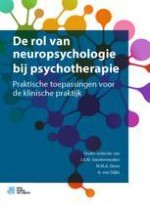Samenvatting
Dit hoofdstuk richt zich op ontwikkelingsneuropsychologische aspecten van de hersenen en het belang van kennis daarvan voor de psychotherapie. Diverse mogelijke oorzaken van het ontstaan van stoornissen in deze ontwikkeling passeren de revue. Genetische oorzaken, zwangerschapsproblemen, aangeboren ziektebeelden, ziekten of deficiënties tijdens de postnatale ontwikkeling en een groot scala aan negatieve omgevingsfactoren worden besproken. De hiërarchische opbouw van de hersenen tijdens de ontwikkeling komt aan de orde, evenals de neuronale ontwikkeling die een leven lang plaatsvindt. Er is aandacht voor de negatieve ontwikkelingsneuropsychologische invloed van (langdurige) vroegkinderlijke stress en dergelijke. Het belang van een ontwikkelings(neuropsychologische) -anamnese wordt belicht, en hiervoor is een vragenlijst bijgevoegd. Ook wordt aangegeven welke bijdrage deze kennis kan leveren aan psychotherapeutische interventies om het risico van stagneren en mogelijk falen van behandeling te reduceren. Het hoofdstuk sluit af met een samenvatting van de belangrijkste aandachtspunten vanuit ontwikkelingsneuropsychologisch perspectief.
